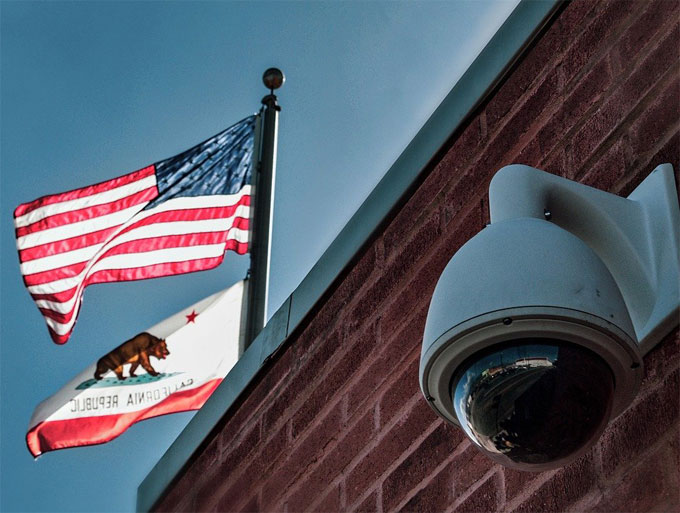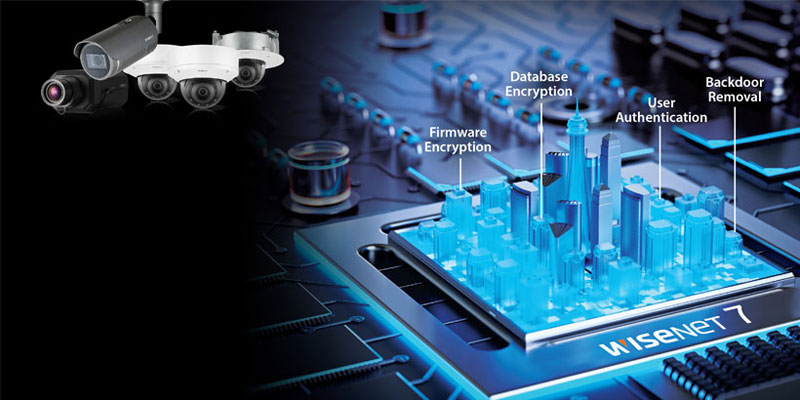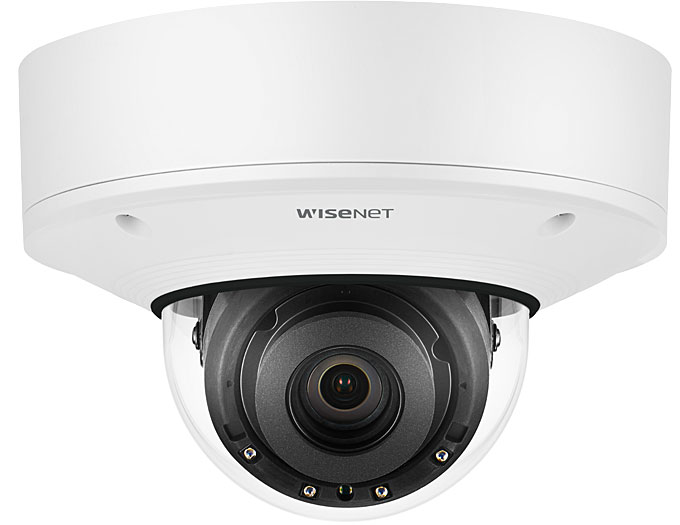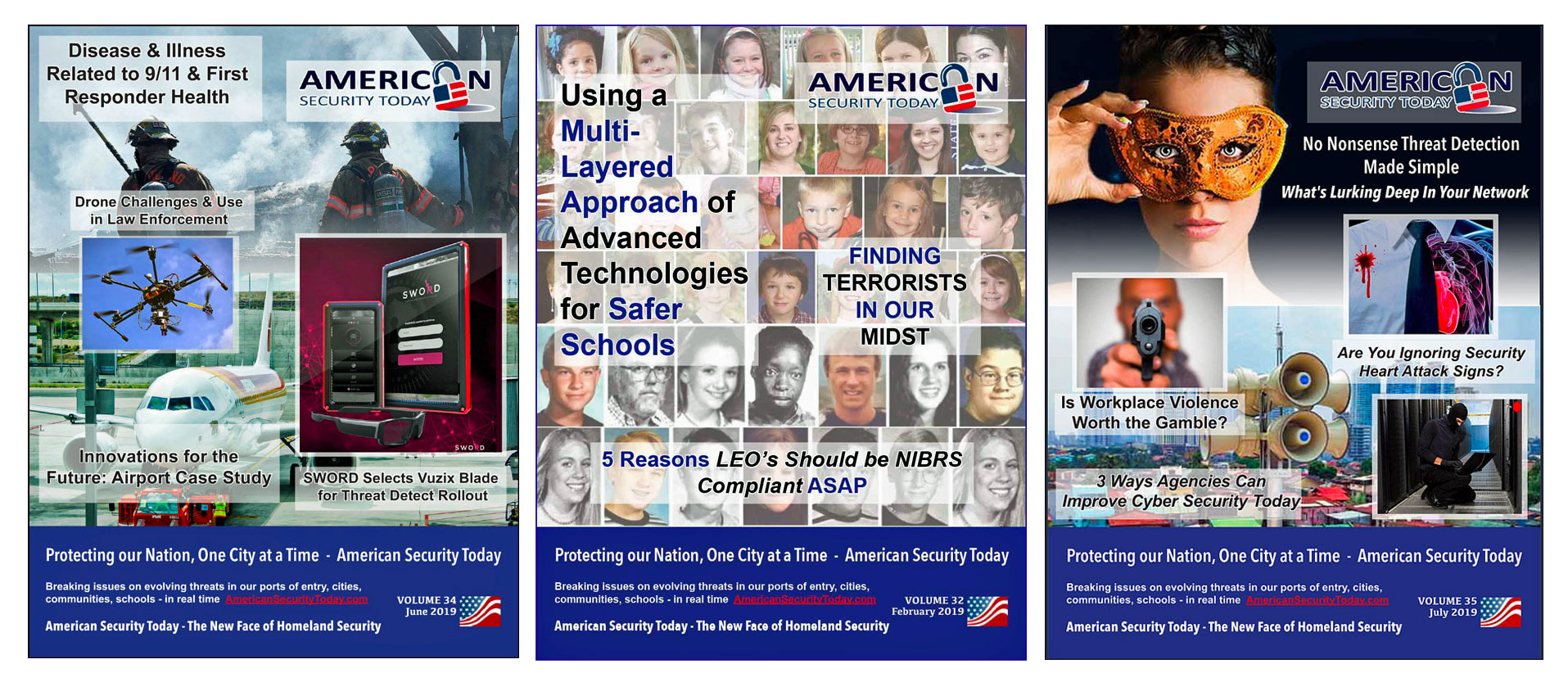
By Matt Clark, Senior Regional Sales Manager, South Mid-Atlantic, Hanwha Techwin America
The requirements and priorities regarding video security for government use can be quite different from the civilian sector.

When reputation, trust, and even lives are on the line, it’s critical that hackers not gain access to any information through your security system, so cybersecurity is of utmost concern.
Performance in challenging, real world conditions, can quickly bring some systems to their knees.
Ease of deployment and bandwidth constraints when sharing network resources can all bubble to the top of the list given the situation.
If you work for a government agency, here are five questions to ask your vendor when considering IP video surveillance cameras.
How cybersecure is your product really?
Cybersecurity is most likely at the top of your list when evaluating products and services. It’s a broad and ever-changing topic.
But getting a straightforward answer to this question can be harder than it should be.
A good place to start is the manufacturing supply chain. Can your vendor articulate what parts are inside a given camera and where they came from?
Many manufacturers depend on 3rd parties to supply critical components such as chips and network interfaces. Are they potentially exploitable?
Everyone has heard about the NDAA (National Defense Authorization Act), and section 889 specifically, that bans certain manufacturers of from selling their video surveillance equipment or parts to any U.S. government-related agency.
This shines a light on supply chains and transparency with regards to “what’s inside” a device and where it came from.
How much of the technology does the manufacturer create and control themselves?
(With its own device certificate issuing system, Root CA, the Wisenet 7 camera lineup offers the highest levels of cybersecurity possible. Secure by Default, Hanwha Techwin’s cybersecurity policy, embeds unique certificates into all products during each step of the development and manufacturing process. This results in a cybersecurity policy that satisfies stringent UL CAP standards as well as our own requirements for product reliability and design innovation. Courtesy of Hanwha Techwin America and YouTube.)
Controlling the entire process leads to a higher integrity product since it hasn’t been touched by a collection of outside vendors or third-party manufacturers.
Beyond the supply chain, it’s important that manufacturers regularly employ external “white hat” hackers to try and break into their systems using the latest exploits available.
Federal agencies will need to utilize the Risk Management Framework (RMF) developed by NIST (National Institute of Standards Technology) to comply with the executive order issued by the President in 2017 regarding cybersecurity.
Is the device certified by other respected agencies such as the UL CAP (Cybersecurity Assurance Program)? Cameras are not all the same with regards to their ability to protect themselves and your network, so it’s important to do the research.
How flexible and efficient is installation and deployment?
For most deployments, it’s important to have smart tools that can bulk install and configure a large number of cameras simultaneously.
As part of the process, there should be a method to automatically generate reports that log and document the installation including credentials, IP assignments, and the different network configurations employed.
The configuration should be backed up in case a product needs to be replaced.
Being able to deploy multiple cameras in a cookie cutter fashion keeps things efficient and consistent as staff come and go over time.
Beyond the cameras, a VMS (video management system) needs to be equally nimble with the ability to handle a broad range of scenarios.

The days of carrying around proprietary servers are gone, so a worthy VMS should be software-based, and efficient enough to run on COTS (commercial off-the-shelf) hardware.
Licensing is an issue that is often overlooked, since some VMS systems require end-users to pay recurring fees to keep a system and number of cameras licensed. Needless to say, being in the field and having a license time out is not acceptable.
Make sure the VMS you choose is fully compatible with the cameras you intend to use. Just because a camera has a certain feature is no guarantee that a given VMS will support it.
It’s also important not to restrict your VMS to a single OS (operating system). Look for a vendor that supports Windows, Linux, and even Mac. A capable VMS should be OS agnostic and allow a variety of secure remote access options from multiple OS platforms.
How often do you roll out firmware? Can I deploy it easily and maintain compliance?
As new weaknesses and exploits are discovered and bugs are fixed, updating firmware on devices is to be expected.
And as companies get more efficient in finding and fixing issues, releasing too many updates can negatively impact an organization that rightly expects things to just work.
These well-intentioned updates need to be deployed in the most seamless way possible for end users.
If rolling out updates is a hassle, then it’s likely to be delayed, if it causes a device to need to re-certify for compliance then it’s a non-starter.
RMF is a set of standards that seeks to streamline product approval and is designed to support firmware and other software updates without a need to re-certify.
When done correctly, the framework makes life easier and even allows for cross-agency approval. E.g., if the DoD has approved and enrolled a certain device or software application in their system, then the Army doesn’t have to run their own multi-month vetting process from scratch.

The inability to adapt in this way was a weakness of the preceding DIACAP standard. The RMF enables departments and agencies to have more access to bleeding edge technology than in the past.
Manufacturers need to have a well thought out roadmap for updates, and when the next revision comes, the process needs to be fast and largely invisible to operations.
What is your performance like in real-world conditions?
Performance can mean different things to different organizations. When talking about cameras, optics are clearly at the top of the list.
Any camera looks great in the daytime but identifying threats against facilities and personnel demands more than excellent lenses and sensors. Real-world conditions require technology that finds detail in shadows while simultaneously controlling exposure for bright areas.
Wide dynamic range is a requirement, and cameras vary considerably in their ability to work in such conditions. Most agencies require extremely low-light performance for outdoor cameras, and you no longer have to settle for black and white images.
The technology is there to present these images in color. Make sure to demand this and take your own test drive in the dark.
non-starter.
(Experience Wisenet7 Extreme WDR demonstration, the future of video surveillance. Courtesy of Hanwha Techwin America and YouTube. Posted on Jul 27, 2020.)
Unlike civilian organizations, most agencies have no shortage of live, dedicated operators to man surveillance equipment.
Regardless of training and dedication, the human brain is designed to filter redundant information which makes it very easy for humans to miss subtle events when staring at multiple video feeds.
The more cameras deployed, the more likely it is that operators will miss events.
Video analytics, and in particular the latest machine learning or AI-based analytics, can make the difference between seeing and reacting to a critical event or completely missing it.
In-camera audio analytics can detect gunshots, glass breaks, and explosions to further verify events.
It’s not a substitute for live operators when you have them, it’s an assist that makes sure they excel at their job and never miss a threat.
(Audio analytics features detect and analyze distinct sounds, such as gunshots, explosions, screams and breaking glass, then immediately raises an alarm to notify users to evaluate the risk of the situation. Courtesy of Hanwha Techwin America and YouTube.)
For post-event forensic research, the same analytics help operators to work smarter, potentially shaving critical hours combing through video manually looking for a needle in a haystack.
Sharing resources in unique environments
Unlike commercial applications, government agencies don’t always have the luxury of a standalone network for their security systems.
Quite the opposite, it’s common for groups to share resources such as network bandwidth with other agencies.
Using highly efficient compression such as the H.265 codec for video can keep a video surveillance system from taking a disproportionate amount of network bandwidth away from other critical systems.
It also enables higher resolutions such as 4K and multi-sensor cameras without taxing the network.
(Wisenet series camera’s streaming performance is greatly enhanced by applying an advanced compression technology called WiseStream. WiseStream can reduce bandwidth by 50% by using Dynamic GOV control technology, and when used with High Efficiency Video Coding (H.265), the bandwidth efficiency can reach up to a 75% savings as compared to other camera technologies. Courtesy of Hanwha Techwin America and YouTube.)
Advanced tools such as facial recognition require more pixels if they are to be accurate.
If operators find themselves throttling down image quality so as not to impact other network traffic, it’s a compromise that could be costly to the mission at hand.
Be sure the technology you choose supports advanced image compression to give you confidence in any environment.
Conclusion
The mission-critical nature of protecting facilities, personnel and important assets, makes it critically important to do your homework when choosing a trusted partner for video surveillance.
Government installations have different priorities for cybersecurity, performance, deployment, and shared resource management.
If possible, find a vendor that can offer most of everything you need.
This “one throat to choke” approach saves valuable time and avoids finger pointing between suppliers.
If you check all the boxes above, it should let your operation work smarter not harder and avoid pitfalls when it counts.
(Wisenet 7 is Hanwha’ most technology-intensive, innovative and feature-rich SoC – offering Vivid 4K Resolution, Extreme WDR with Scene Analysis technology, Sharper images with enhanced noise reduction technology, DIS with built-in gyro sensor, Enhanced Lens Distortion Correction, End-to-end Cybersecurity, License-free intelligent video and audio analytics, and AI-based object tracking. Courtesy of Hanwha Techwin America and YouTube.)
To Learn More you can connect with Matt at LinkedIn here, or please visit HanwhaSecurity.com.
About the Author

Matt Clark is the Senior Regional Sales Manager at Hanwha Techwin America where he focuses on Federal, State and Local Government customers.
Prior to Hanwha, Matt was Eastern US Sales Manager at Veracity USA and has over 12 years of experience in the security industry.
Hanwha Techwin America Takes Double Platinum in the 2020 ‘ASTORS’ Awards
American Security Today’s ‘ASTORS’ Homeland Security Awards program is now in its Sixth Year and continues to recognize the Outstanding Innovations of top firms and agencies in the Homeland Security and Public Safety fields.
2020 was a very challenging year for everyone due to the COVID-19 pandemic and the much heralded AST ‘ASTORS’ Awards Winners Presentations and exclusive Luncheon at the Jacob Javits Center in NYC had to be canceled and rescheduled for 2021 due to the virus.

However, the 2020 ‘ASTORS’ Homeland Security Awards Program was again a huge success and many new categories were added including a section for COVID-19 Detection and Innovation.
Hanwha Techwin America (First of Two)
Best CCTV Technology
-
PNV-A9081R4K Network AI IR Vandal Dome Camera
-
The PNV-A9081R is an AI-based camera that captures pristine images at up to 4K resolution while including powerful, in-camera deep learning algorithms for advanced object detection, classification and error and license-free analytics.
-
Utilizing object recognition versus motion detection all but eliminates false alarms while also providing valuable business and operations insight.

-
The PNV-A9081R dome camera is NDAA compliant and comes in a modular form factor with an open platform for 3rd party applications, and key features include WDR (120dB), Simple focus, H.265/H.264/MJPEG, WiseStreamⅡ compression technology, USB port for easy installation, Advanced video analytics and sound classification, True D/N, Dual SD card, Hallway view, DIS using a Gyro sensor.
-
Video Analytics based on AI, Object detection and classification(Person, Face, Vehicle, License Plate), Attribute, BestShot, Compatible with Wisenet Retail Insight v2.0 for business intelligence, age/gender-based people counting, heatmap, queue management, modular structure for easy installation, POE+/12VDC.
-
The new face mask detection analytic can detect if people are wearing/not wearing a face mask and provide notification to compatible VMS/NVRs. Face Masks are now part of the face attribute metadata for easy forensic review.
Hanwha Techwin America (Second of Two)
Best COVID-19 Detection Innovation
-
Occupancy Monitor Open Platform Application for P – Series AI Cameras
-
The Hanwha Techwin Occupancy Monitoring System combines 4K camera resolution with edge-based AI video analytics so you can easily maintain safe building occupancy levels to protect employees and customers.
-
The application provides government facilities with highly accurate, real-time data on the number of people entering and leaving a building, and also provides retailers, houses of worship, museums, entertainment facilities, restaurants and more with highly accurate, real-time data on the number of people in a facility at any given time.
(Easily monitor public spaces to maintain safe occupancy levels. The Hanwha Techwin Occupancy Monitoring System combines 4K camera resolution with edge-based AI video analytics so you can easily maintain safe building occupancy levels to protect employees and customers. Courtesy of Hanwha Techwin America and YouTube.)
-
When a pre-set maximum capacity level is reached, the application generates alarm outputs to control automatic doors or a traffic light beacon.
-
The Occupancy Monitoring System also generates red “wait” or green “enter” customizable text messages that can be displayed on monitors.
-
The system aggregates occupancy data from up to 8 cameras at 8 entrances/exists simultaneously, making it suitable for not only small business but also large enterprise.
-
*Hanwha Techwin America was also recognized in the 2019 and 2018 ‘ASTORS’ Homeland Security Awards Programs.
The 2020 ‘ASTORS’ Awards Program was sponsored by ATI Systems, Attivo Networks, Automatic Systems, Desktop Alert, X.Labs and Reed Exhibitions, every one a returning Sponsor from 2020, 2019 and More.

Nominations are now being accepted for the 2021 ‘ASTORS’ Homeland Security Awards at https://americansecuritytoday.com/ast-awards/.
Comprehensive List of Categories Include:
Access Control/ Identification Personal/Protective Equipment Law Enforcement Counter Terrorism Perimeter Barrier/ Deterrent System Interagency Interdiction Operation Cloud Computing/Storage Solution Facial/IRIS Recognition Body Worn Video Product Cyber Security Video Surveillance/VMS Mobile Technology Anti-Malware Audio Analytics Disaster Preparedness ID Management Thermal/Infrared Camera Mass Notification System Fire & Safety Metal/Weapon Detection Rescue Operations Critical Infrastructure License Plate Recognition Detection Products And Many Others! COVID Innovations And Many Others! Don’t see a Direct Hit for your Product, Agency or Organization?

The World Health Organization (WHO) declared the 2019–20 coronavirus outbreak a Public Health Emergency of International Concern (PHEIC) on 30 January 2020 and a pandemic on 11 March 2020. Local transmission of the disease has occurred across all fifty states in the America. With the unprecedented occurrence of the COVID-19 pandemic, the focus of the safety and security industries has realized the need to increase innovations to address the daily growing challenges.
As such AST aims to make sure these firms and professionals are reflected in the 2021 ‘ASTORS’ Awards Program, so we’d like to encourage you to submit appropriate categories recommendations and include COVID-19 Frontline Professionals in your Nominations to see that these Professionals, Facilities, and Vendors receive the Recognition they Deserve!
Submit your category recommendation for consideration to Michael Madsen, AST Publisher at: mmadsen@americansecuritytoday.com.
Why American Security Today?
The traditional security marketplace has long been covered by a host of publications putting forward the old school basics to what is Today – a fast changing security landscape.

The traditional security marketplace has long been covered by a host of publications putting forward the old school basics to what is Today – a fast changing security landscape.
American Security Today is uniquely focused on the broader Homeland Security & Public Safety marketplace with over 75,000 readers at the Federal, State and local levels of government as well as firms allied to government.
American Security Today brings forward a fresh compelling look and read with our customized digital publications that hold readers eyes throughout the story with cutting edge editorial that provides solutions to their challenges.
Harness the Power of the Web – with our 100% Mobile Friendly Publications

AST puts forward the Largest and Most Qualified Circulation in Government with Over 75,000 readers on the Federal, State and Local levels. The AST Digital Publications is distributed to over 75,000 qualified government and homeland security professionals in federal, state and local levels.
‘PROTECTING OUR NATION, ONE CITY AT A TIME’
AST Reaches both Private & Public Experts, essential to meeting these new challenges.
Today’s new generation of public safety and security experts need real-time knowledge to deal with domestic and international terrorism, lone wolf attacks, unprecedented urban violence, shifts in society, culture and media bias – making it increasingly difficult for Homeland Security, Law Enforcement, First Responders, Military and Private Security Professionals to implement coordinated security measures to ensure national security and improve public safety.
These experts are from Government at the federal, state and local level as well as from private firms allied to government.
AST provides a full plate of topics in our AST Monthly Magazine Editions, AST Website and AST Daily News Alerts, covering 23 Vital Sectors such as Access Control, Perimeter Protection, Video Surveillance/Analytics, Airport Security, Border Security, CBRNE Detection, Border Security, Ports, Cybersecurity, Networking Security, Encryption, Law Enforcement, First Responders, Campus Security, Security Services, Corporate Facilities, and Emergency Response among others.
AST has Expanded readership into integral Critical Infrastructure audiences such as Protection of Nuclear Facilities, Water Plants & Dams, Bridges & Tunnels, and other potential targets of terrorism.
Other areas of concern include Transportation Hubs, Public Assemblies, Government Facilities, Sporting & Concert Stadiums, our Nation’s Schools & Universities, and Commercial Business Destinations – all enticing targets due to the large number of persons and resources clustered together.

To learn more about the 2020 ‘ASTORS’ Homeland Security Award Winners solutions, Check Out the New 2020 ‘ASTORS’ CHAMPIONS Edition Fully Interactive Magazine – the Best Products of 2020 ‘A Year in Review’.
The Annual CHAMPIONS edition includes a review of the ‘ASTORS’ Award Winning products and programs, highlighting key details on many of the winning firms products and services, includes video interviews and more.
 It is your Go-To source throughout the year for ‘The Best of 2020 Products and Services‘ endorsed by American Security Today, and can satisfy your agency’s and organization’s most pressing Homeland Security and Public Safety needs.
It is your Go-To source throughout the year for ‘The Best of 2020 Products and Services‘ endorsed by American Security Today, and can satisfy your agency’s and organization’s most pressing Homeland Security and Public Safety needs.From Physical Security (Access Control, Critical Infrastructure, Perimeter Protection and Video Surveillance Cameras and Video Management Systems), to IT Security (Cybersecurity, Encryption, Data Storage, Anti-Malware and Networking Security – Just to name a few), the 2020 ‘ASTORS’ CHAMPIONS EDITION has what you need to Detect, Delay, Respond to, and Mitigate today’s real-time threats in our constantly evolving security landscape.
It also includes featured guest editorial pieces from some of the security industry’s most respected leaders, and recognized firms in the 2020 ‘ASTORS’ Awards Program.
-
For a complete list of 2020 ‘ASTORS’ Award Winners, click here.
For more information on All Things American Security Today, and the 2021 ‘ASTORS’ Awards Program, please contact Michael Madsen, AST Publisher at mmadsen@americansecuritytoday.com.
AST strives to meet a 3 STAR trustworthiness rating, based on the following criteria:
- Provides named sources
- Reported by more than one notable outlet
- Includes supporting video, direct statements, or photos
Subscribe to the AST Daily News Alert Here.
-


















